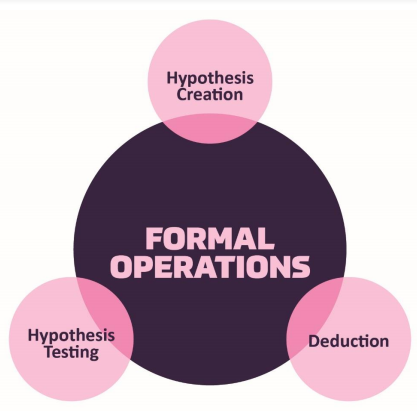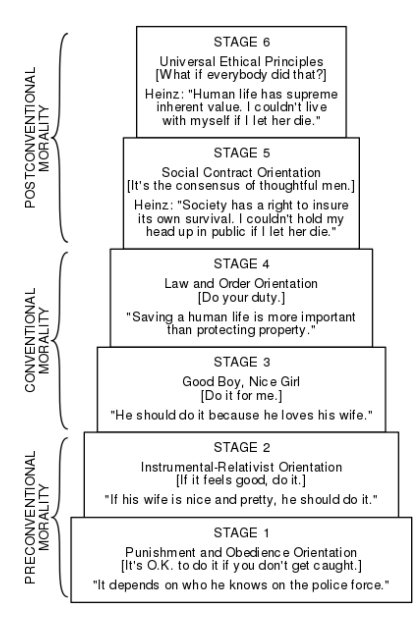14.3: Cognitive Theorists- Piaget, Elkind, Kohlberg, and Gilligan
- Last updated
- Save as PDF
- Page ID
- 105571
Jean Piaget: Formal Operational Stage of Cognitive Development
Cognition refers to thinking and memory processes, and cognitive development refers to long-term changes in these processes. One of the most widely known perspectives about cognitive development is the cognitive stage theory of a Swiss psychologist named Jean Piaget. Piaget created and studied an account of how children and youth gradually become able to think logically and scientifically. Because his theory is especially popular among educators, we focus on it in this chapter.
Piaget was a psychological constructivist: in his view, learning was proceeded by the interplay of assimilation (adjusting new experiences to fit prior concepts) and accommodation (adjusting concepts to fit new experiences). The to-and-fro of these two processes leads not only to short-term learning, but also to long-term developmental change. The long-term developments are really the main focus of Piaget’s cognitive theory.
As you might remember, Piaget proposed that cognition developed through distinct stages from birth through the end of adolescence. By stages he meant a sequence of thinking patterns with four key features:
- They always happen in the same order.
- No stage is ever skipped.
- Each stage is a significant transformation of the stage before it.
- Each later stage incorporated the earlier stages into itself.
Basically this is the “staircase” model of development. Piaget proposed four major stages of cognitive development, and called them (1) sensorimotor intelligence, (2) preoperational thinking, (3) concrete operational thinking, and (4) formal operational thinking. Each stage is correlated with an age period of childhood, but only approximately. Formal operational thinking appears in adolescence. 4
During the formal operational stage, adolescents are able to understand abstract principles. They are no longer limited by what can be directly seen or heard, and are able to contemplate such constructs as beauty, love, freedom, and morality. Additionally, while younger children solve problems through trial and error, adolescents demonstrate hypothetical-deductive reasoning, which is developing hypotheses based on what might logically occur. They are able to think about all the possibilities in a situation beforehand, and then test them systematically, (Crain, 2005) because they are able to engage in true scientific thinking.


Does everyone reach formal operations?
According to Piaget, most people attain some degree of formal operational thinking, but use formal operations primarily in the areas of their strongest interest (Crain, 2005). In fact, most adults do not regularly demonstrate formal operational thought. A possible explanation is that an individual’s thinking has not been sufficiently challenged to demonstrate formal operational thought in all areas.
Adolescent Egocentrism
Once adolescents can understand abstract thoughts, they enter a world of hypothetical possibilities and demonstrate egocentrism, a heightened self-focus. The egocentricity comes from attributing unlimited power to their own thoughts (Crain, 2005). Piaget believed it was not until adolescents took on adult roles that they would be able to learn the limits to their own thoughts.
David Elkind: On Piaget’s Theory
David Elkind (1967) expanded on the concept of Piaget’s adolescent egocentricity. Elkind theorized that the physiological changes that occur during adolescence result in adolescents being primarily concerned with themselves. Additionally, since adolescents fail to differentiate between what others are thinking and their own thoughts, they believe that others are just as fascinated with their behavior and appearance. This belief results in the adolescent anticipating the reactions of others, and consequently constructing an imaginary audience. The imaginary audience is the adolescent’s belief that those around them are as concerned and focused on their appearance as they themselves are (Schwartz, Maynard, & Uzelac, 2008, p. 441). Elkind thought that the imaginary audience contributed to the self-consciousness that occurs during early adolescence. The desire for privacy and the reluctance to share personal information may be a further reaction to feeling under constant observation by others.

Another important consequence of adolescent egocentrism is the personal fable or belief that one is unique, special, and invulnerable to harm. Elkind (1967) explains that because adolescents feel so important to others (imaginary audience) they regard themselves and their feelings as being special and unique. Adolescents believe that only they have experienced strong and diverse emotions, and therefore others could never understand how they feel. This uniqueness in one’s emotional experiences reinforces the adolescent’s belief of invulnerability, especially to death. Adolescents will engage in risky behaviors, such as drinking and driving or unprotected sex, and feel they will not suffer any negative consequences. Elkind believed that adolescent egocentricity emerged in early adolescence and declined in middle adolescence, however, recent research has also identified egocentricity in late adolescence (Schwartz, et al., 2008).
Consequences of Formal Operational Thought
As adolescents are now able to think abstractly and hypothetically, they exhibit many new ways of reflecting on information (Dolgin, 2011). For example, they demonstrate greater introspection or thinking about one’s thoughts and feelings. They begin to imagine how the world could be, which leads them to become idealistic or insisting upon high standards of behavior. Because of their idealism, they may become critical of others, especially adults in their life. Additionally, adolescents can demonstrate hypocrisy, or pretend to be what they are not. Since they are able to recognize what others expect of them, they will conform to those expectations for their emotions and behavior seemingly hypocritical to themselves. Lastly, adolescents can exhibit pseudostupidity, which is when they approach problems at a level that is too complex and they fail because the tasks are too simple. Their new ability to consider alternatives is not completely under control and they appear “stupid” when they are in fact bright, just inexperienced. 8
Lawrence Kohlberg: Moral Development
Kohlberg (1963) built on the work of Piaget and was interested in finding out how our moral reasoning changes as we get older. He wanted to find out how people decide what is right and what is wrong (moral justice). Just as Piaget believed that children’s cognitive development follows specific patterns, Kohlberg argued that we learn our moral values through active thinking and reasoning, and that moral development follows a series of stages. Kohlberg's six stages are generally organized into three levels of moral reasons. To study moral development, Kohlberg posed moral dilemmas to children, teenagers, and adults. You may remember one such dilemma, the Heinz dilemma, that was introduced in Chapter 12: 9
A woman was on her deathbed. There was one drug that the doctors thought might save her. It was a form of radium that a druggist in the same town had recently discovered. The drug was expensive to make, but the druggist was charging ten times what the drug cost him to produce. He paid $200 for the radium and charged $2,000 for a small dose of the drug. The sick woman's husband, Heinz, went to everyone he knew to borrow the money, but he could only get together about $1,000 which is half of what it cost. He told the druggist that his wife was dying and asked him to sell it cheaper or let him pay later. But the druggist said: “No, I discovered the drug and I'm going to make money from it.” So Heinz got desperate and broke into the man's laboratory to steal the drug for his wife. Should Heinz have broken into the laboratory to steal the drug for his wife? Why or why not? 10
Based on their reasoning behind their responses (not whether they thought Heinz made the right choice or not), Kohlberg placed each person in one of the stages as described in the image on the following page:

Although research has supported Kohlberg’s idea that moral reasoning changes from an early emphasis on punishment and social rules and regulations to an emphasis on more general ethical principles, as with Piaget’s approach, Kohlberg’s stage model is probably too simple. For one, children may use higher levels of reasoning for some types of problems, but revert to lower levels in situations where doing so is more consistent with their goals or beliefs (Rest, 1979). Second, it has been argued that this stage model is particularly appropriate for Western countries, rather than non-Western, samples in which allegiance to social norms (such as respect for authority) may be particularly important (Haidt, 2001). In addition, there is little correlation between how children score on the moral stages and how they behave in real life.
Perhaps the most important critique of Kohlberg’s theory is that it may describe the moral development of boys better than it describes that of girls. Carol Gilligan has argued that, because of differences in their socialization, males tend to value principles of justice and rights, whereas females value caring for and helping others. Although there is little evidence that boys and girls score differently on Kohlberg’s stages of moral development (Turiel, 1998), it is true that girls and women tend to focus more on issues of caring, helping, and connecting with others than do boys and men (Jaffee & Hyde, 2000). 12
Carol Gilligan: Morality of Care
Carol Gilligan, whose ideas center on a morality of care, or system of beliefs about human responsibilities, care, and consideration for others, proposed three moral positions that represent different extents or breadth of ethical care. Unlike Kohlberg, or Piaget, she does not claim that the positions form a strictly developmental sequence, but only that they can be ranked hierarchically according to their depth or subtlety. In this respect her theory is “semi-developmental” in a way similar to Maslow’s theory of motivation (Brown & Gilligan, 1992; Taylor, Gilligan, & Sullivan, 1995). The following table summarizes the three moral positions from Gilligan’s theory:
| Moral Positions | Definition of What is Morally Good |
|---|---|
| Position 1: Survival Orientation | Action that considers one’s personal needs only |
| Position 2: Conventional Care |
Action that considers others’ needs or preferences but no one’s own |
| Position 3: Integrated Care |
Action that attempts to coordinate one’s own personal needs with those of others |
Position 1: Caring as Survival
The most basic kind of caring is a survival orientation, in which a person is concerned primarily with his or her own welfare. As a moral position, a survival orientation is obviously not satisfactory for classrooms on a widespread scale. If every student only looked out for himself or herself alone, classroom life might become rather unpleasant. Nonetheless, there are situations in which caring primarily about yourself is both a sign of good mental health and also relevant to teachers. For a child who has been bullied at school or sexually abused at home, for example, it is both healthy and morally desirable to speak out about the bullying or abuse—essentially looking out for the victim’s own needs at the expense of others’, including the bully’s or abuser’s. Speaking out requires a survival orientation and is healthy because in this case, the child is at least caring about herself.
Position 2: Conventional Caring
A more subtle moral position is caring for others, in which a person is concerned about others’ happiness and welfare, and about reconciling or integrating others’ needs where they conflict with each other. In classrooms, students who operate from Position 2 can be very desirable in some ways; they can be kind, considerate, and good at fitting in and at working cooperatively with others. Because these qualities are very welcome in a busy classroom, it can be tempting for teachers to reward students for developing and using them for much of their school careers. The problem with rewarding Position 2 ethics, however, is that doing so neglects the student’s identity—his or her own academic and personal goals or values. Sooner or later, personal goals, values and identity need attention, and educators have a responsibility for assisting students to discover and clarify them. Unfortunately for teachers, students who know what they want may sometimes be more assertive and less automatically compliant than those who do not.
Position 3: Integrated Caring
The most developed form of moral caring in Gilligan’s model is integrated caring, the coordination of personal needs and values with those of others. Now the morally good choice takes account of everyone including yourself, not everyone except yourself.
In classrooms, integrated caring is most likely to surface whenever teachers give students wide, sustained freedom to make choices. If students have little flexibility about their actions, there is little room for considering anyone’s needs or values, whether their own or others’. If the teacher says simply, “Do the homework on page 50 and turn it in tomorrow morning,” then compliance becomes the main issue, not moral choice. But suppose instead that she says something like this: “Over the next two months, figure out an inquiry project about the use of water resources in our town. Organize it any way you want—talk to people, read widely about it, and share it with the class in a way that all of us, including yourself, will find meaningful.” Although an assignment this general or abstract may not suit some teachers or students, it does pose moral challenges for those who do use it. Why? For one thing, students cannot simply carry out specific instructions, but must decide what aspect of the topic really matters to them. The choice is partly a matter of personal values. For another thing, students have to consider how the topic might be meaningful or important to others in the class. Third, because the time line for completion is relatively far in the future, students may have to weigh personal priorities (like spending time with family on the weekend) against educational priorities (working on the assignment a bit more on the weekend). Some students might have trouble making good choices when given this sort of freedom—and their teachers might therefore be cautious about giving such an assignment. But in a way these hesitations are part of Gilligan’s point: integrated caring is indeed more demanding than the caring based on survival or orientation to others, and not all students may be ready for it. 13
We’ve learned that major changes in the structure and functioning of the brain occur during adolescence and result in the theories about cognitive and behavioral developments (Steinberg, 2008). These cognitive changes include how information is processed, and are fostered by improvements in cognitive function during early adolescence such as in memory, encoding, and storage as well as ability to think about thinking, therefore becoming better at information processing functions. 14
Contributors and Attributions
4. Educational Psychology – Cognitive Development: The Theory of Jean Piaget by Kelvin Seifert and Rosemary Sutton is licensed under CC BY
8. Lifespan Development: A Psychological Perspective by Martha Lally and Suzanne Valentine-French is licensed under CC BY-NC-SA 3.0
9. Lifespan Development – Module 6: Middle Childhood references Psyc 200 Lifespan Psychology by Laura Overstreet, which is licensed under CC BY
Beginning Psychology – Chapter 6: Growing and Developing by Charles Stangor is licensed under CC BY-NC-SA 3.0
10. Heinz Dilemma by Wikipedia is licensed under CC BY 3.0
12. Beginning Psychology – Chapter 6: Growing and Developing by Charles Stangor is licensed under CC BY-NC-SA 3.0
13. Educational Psychology - 4.5 Moral Development: forming a sense of rights and responsibilities by CNX Psychology is licensed under CC BY 4.0
Contemporary Educational Psychology/Chapter 3: Student Development/Moral Development by Wikibooks is licensed under CC BY-SA 3.0
14. Content by Dawn Rymond is licensed under CC BY 4.0


